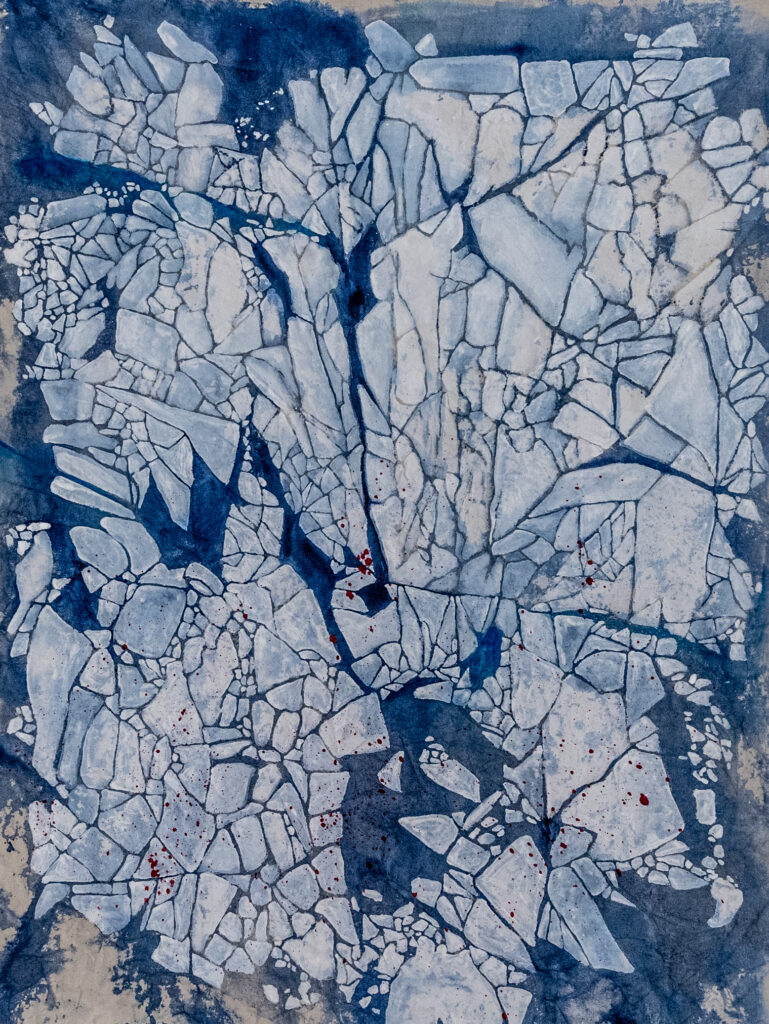
I began thinking about issues of materiality last year when preparing for the final Glacial Narratives exhibition. It was vital to the foundation of the artworks that I was creating to draw inspiration not only from the imagery of Greenland and the Arctic ice, but also from the materiality of the lived experience of the high Arctic. That I was fortunate to be able to address as I lived on Svalbard and the physical materials of midnight sun and glacier water for exposing and fixing the Eqi glacier cyanotype were at my fingertips. To further the material relationship a friend of mine who hunts seal gave me a bucket of seal blubber to render for the oil to make the photocopies transparent. All the cyanotypes were created using these materials common to the Arctic experience of Svalbard and Greenland.
I struggled with how to bring that same materiality to the paintings I was doing. Part of it came from salvaging local found materials to hang them from. But the last of the painting I tried something different. Instead of hanging it flat on the wall and then working on it, I thought about sea ice, and its shapes, its randomness and how difficult it is for humans to make things truly random. This time, I crumpled the canvas into a ball and soaked it in water in my sink. Then I attached to the wall and quickly flung paint at it. When it was dry all the creases and marks from being crumpled remained, and I used those random wrinkles to direct how the ice would be formed.
The painting looked almost exactly like sea ice, and unintentionally also bore a resemblance to the map of Svalbard. The image stayed with me through the months of exhibiting, of packing, of travel, of setting up a new apartment, a new studio. I knew I wanted to continue working letting the randomness of the canvas guide me.
The new question has become how do I relate where I am now to where I have been, and what I want to say with my work. I’ve been thinking about this for months. Thinking about this place, the valleys scraped out by glaciers. Thinking about how, on top of Mt. Erie the information sign said that, during the Quarternary Period, three miles of glacier rested atop this hill. Thinking about how our rivers descend from the glaciers in the North Cascades, literally feeding us. Thinking about how to create the connection between the glaciers that formed this land and still exist in the mountains, and the melting glaciers and sea ice in the Arctic.
My thinking returned to that last canvas, and my struggles with materiality. Yesterday I tore off a big square-ish chunk of canvas, then parked by an access to Kristofferson creek. I crumpled up my canvas and soaked it in the mahogany colored creek, thick with dead leaves, mossy rocks, and dying reeds. I swished it around until it was throughly wet and brown. Then I took it back to the Five Acre Woods, hung it up, then hosed off all the debris — sticks and leaves and algal stuff. I left it to dry over night.
Today I began work on it. First, soaking it with water and sloshing around washes of Prussian blue, but not covering the canvas with blue as I did before. I want those mottled areas of browns and rusts and weird dark greens to remain. As a test of proof of concept, I painted a small center section. I honestly could not be more thrilled with the results. Of course this is just a start, but it looks very much like this will say everything I want it to say, and it is a joining of place and time in this physical object. And that delights me.
Look forward to hearing more❤️